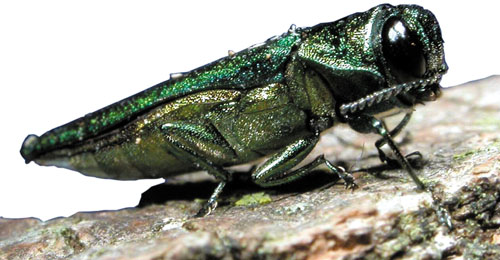‘Destructive’ emerald ash borer found in Iowa

The emerald ash borers have been found in in Cedar County, Iowa. The outbreak is the state’s fourth in the past three years.
October 15, 2013
The movement of firewood and wood chips from Iowa could soon be under quarantine as emerald ash borers have been found in Mechanicsville, Iowa, in Cedar County.
This is the fourth outbreak of the pest found in Iowa, following infestations in Allamakee, Des Moines and Jefferson counties, all in the last three years. The emerald ash borer is generally spread by the movement of firewood, though it can also be spread through landscaping.
The borers are exotic beetles from Asia that is generally half an inch long or smaller. They feed solely on ash trees, which are one of the most abundant tree species in America.
“[The emerald ash borer] is very destructive,” said Mark Shour, entomologist at Iowa State and member of the Iowa Emerald Ash Borer Team. “It will kill healthy or declining trees. … It takes two to five years to destroy one tree.”
Ash is used in a number of products including: firewood, paper, baseball bats and basket weaving, as well as being a common shade tree in urban areas. Replacing all 38 million urban ash trees in the United States would cost $25 billion, and replacing the 8 billion forest trees would cost $282 billion.
Since its discovery in 2002 in Detroit, the beetle has spread to 22 states and destroyed tens of millions of trees, according to the U.S. Department of Agriculture. $206 million have been spent in trying to combat it and prevent it from spreading further.
The Iowa Emerald Ash Borer Team plans to do this by “raising awareness, educating the public, encouraging people not to bring in firewood and to help them protect their ash trees,” Shour said. “One big sign of [the emerald ash borer] is woodpeckers. They remove the bark and go for the larvae.”
However, the beetle cannot be detected until several years after the infestation has begun. The only way to discover if a tree is infected is to look for the symptoms and then remove the bark from the tree. The Iowa Department of Agriculture, the Iowa Department of Natural Resources and ISU Extension are already busy looking for more infestations.
Symptoms include canopy thinning, bark splits and cracks, and epicormic sprouting according to IowaTreePests.com, a site set up by the Iowa Department of Agriculture to educate the public on various pests and to provide resources for combatting them.
EAB cannot be simply eradicated. It has no natural predators in the United States and pesticides have not yet been developed to combat it. It only takes one tree being infested to declare an outbreak.
“Once one is found, oftentimes we find many more,” Shour said.
The details of the quarantine in Iowa are still being determined because so many product industries use ash trees. Once in place, the quarantine is unlikely to be lifted for a long time. This quarantine will prevent the movement of all unprocessed ash, and permission must be obtained from the Iowa Department of Agriculture to move all other ash products.
To diagnose if a tree has been infested, samples can be submitted to the Plant and Insect Diagnostic Clinic at 327 Bessey Hall.
















